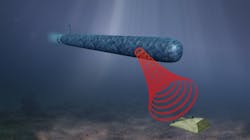General Dynamics eyes full-scale development on unmanned Knifefish minehunting UUV for LCS, other Navy ships
WASHINGTON – unmanned underwater vehicle (UUV) designers at General Dynamics Corp. will begin early production of the Knifefish minehunting UUV under terms of a $44.6 million order announced last week.
Officials of the U.S. Naval Sea Systems Command in Washington are asking the General Dynamics Mission Systems segment in McLeansville, N.C., to start low-rate initial production (LRIP) on the Surface Mine Countermeasure UUV, also known as Knifefish.
The step to LRIP means General Dynamics will begin building a small number of the Knifefish UUV for initial operational test and evaluation, and start tooling-up for full production of the minehunting unmanned submarine.
Knifefish is for deployment from the Navy littoral combat ship (LCS), other suitable surface vessels, or from shore to detect and classify buried, bottom, and volume mines in high-clutter environments. Volume mines are suspended at shallow depths and are designed to break the keels of ships passing over them.
The Knifefish system has two UUVs and support systems, low-frequency broadband sonar, and automated target-recognition software to act as an off-board sensor while the host ship stays safely away from the mine field.The Knifefish minehunting UUV has a common open-systems architecture that offers modularity to enable the undersea vessel to carry out a wide variety of countermine, surveillance, and reconnaissance missions. Planned upgrades will improve its sensors and automated target-recognition software to keep pace with mine threats, Navy officials say.
Navy experts supervised testing earlier this year off the coasts of Massachusetts and Florida against a deployed simulated target field. Sailors during testing performed mission planning, launching and recovering the system, monitoring the sorties, and processing data.
The unmanned undersea vehicles were deployed from a support craft in the vessels of opportunity configuration for all test events in order to provide a characterization of the performance of the entire Knifefish system, including the launch and recovery subsystem.
Full-rate Knifefish is expected in 2022 after additional testing. Navy officials plan to buy 30 Knifefish systems -- 24 for the LCS and six for other Navy vessels.
The Knifefish UUV is based on the Bluefin 21 UUV, which Bluefin Robotics in Quincy, Mass., developed for deep-dive research and counter-mine operations. General Dynamics acquired Bluefin Robotics in 2016.
The Bluefin 21, on which Knifefish is based, is 16.2 feet long, 21 inches in diameter, and weighs 1,650 pounds. The unmanned undersea vehicle can operate to depths to 14,763 feet, and can operate for as long as 25 hours between battery recharges.
The undersea vehicle can store as much as 13.5 kilowatt-hours of energy in nine 1.5-kilowatt-hour batter packs. Powering the Bluefin-21 is a gimbaled ducted thruster, and navigation comes from inertial navigation, remote operation, and Global Positioning System (GPS) satellite navigation.
The UUV has an integrated GPS, radio-frequency, Iridium, and strobe antenna, and communicates with operators via radio frequency links, Iridium satellite communications, and acoustic communications systems.
The Bluefin-21 data capability includes a four-gigabyte flash drive for vehicle data storage. Standard payloads include the EdgeTech 2200-M 120/410 kHz side-scan sonar, EdgeTech DW-216 sub-bottom profiler, and Reson 7125 400 kHz multibeam echosounder.
On this order General Dynamics will do the work in Quincy, Taunton, and Braintree Mass.; McLeansville, N.C.; Reston, Va.; and Ann Arbor, Mich., and should be finished by August 2021.
For more information contact General Dynamics Mission Systems online at https://gdmissionsystems.com, or Naval Sea Systems Command at www.navsea.navy.mil.

John Keller | Editor-in-Chief
John Keller is the Editor-in-Chief, Military & Aerospace Electronics Magazine--provides extensive coverage and analysis of enabling electronics and optoelectronic technologies in military, space and commercial aviation applications. John has been a member of the Military & Aerospace Electronics staff since 1989 and chief editor since 1995.

